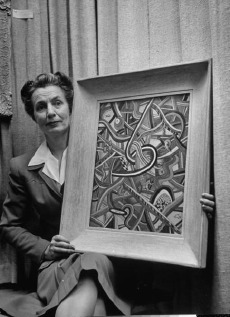
A woman displays "Three Out of Five" by Naromji. (
Life Archive)
In November 1946 the Los Angeles Art Association included a painting titled "Three Out of Five", by a previously unknown artist, Naromji, in an exhibition of abstract art. The work hung beside works by well-known modern artists such as Helen Lundeberg and Stanton Macdonald-Wright, and it was given a price tag of $1000. But the Art Association was embarrassed when, at the end of the month, the publicist/prankster Jim Moran revealed that he was the true author of the painting. Naromji was Moran spelled backwards, with a 'ji' "added for confusion."
The painting was described by the
Los Angeles Times as "an astonishing conglomeration of paint, chalk, magazine cut-outs and carmine fingernail polish." It consisted of a series of swirls and triangles. In the spaces between the lines, the artist had placed small pictures that included a fish, a head, an arm, a leg cut from a lingerie advertisement, and one of comedian Fred Allen's eyes.
Moran said that he perpetrated the hoax because he had always been suspicious of "long-haired art." Therefore, he "sat down and dreamed up the worst thing I could think of." The title, "Three Out of Five," referred to a brand of hair restorer since, as Moran said, abstract painting made him want to "tear his hair."
The composer George Antheil served as the frontman for the hoax, donating the painting to the Art Association for Moran, claiming merely that it was the work of a friend. However, Antheil later claimed that while he had accepted Moran's request to deliver the work, he hadn't realized Moran himself was its author.
In response to the hoax, the Art Association explained that they had accepted the work largely because they had suspected it might have been a work by Antheil himself. A spokesman said, "Mr. Antheil acted so coy about the whole thing that we got the impression he painted 'Three Out of Five.' The whole flavor of the picture was reminiscent of 'dadaism,' an infantile school of music which Mr. Antheil favored after World War I. It looked the way some of his earlier music sounded."
The Art Association also criticized the hoax, arguing it could make it harder for young, unknown artists to get their work displayed.
An extra layer of controversy was subsequently added to the hoax when the artist Leonard Kester claimed the work was actually his own. He said that Moran had watched him paint it, and had then sent the work to the exhibit while he was out of town. This led the Art Association to claim they had been right to accept the picture in the first place. Journalist Travis Hoke noted, "Done by Artist Kester, it was art. Done by non-artist Moran, it was not." Moran did not comment on Kester's claim of authorship.
Links and References
- "Gagster's masterpiece hung as authentic art." (Nov 30, 1946). Los Angeles Times.
- Hoke, Travis. (Apr 20, 1947). "Screwball Moran takes up modern art." The American Weekly.

Comments